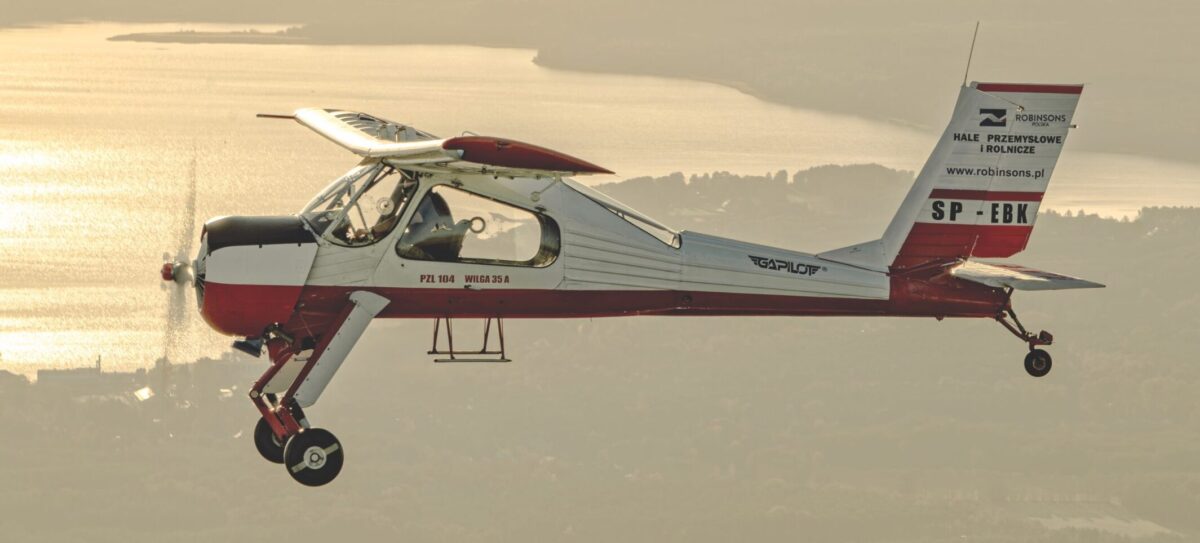Aircraft figured prominently in Poland’s fight for existence within two years of its restoration as a nation in 1918 and within the following decade it established a modest but up-to-date aircraft industry. After the ravages of World War II and the limitations placed on its aircraft production as a member of the Warsaw Pact (the mainstays of its air force being Soviet designs built under license), Poland continued to produce an impressive share of imaginative aircraft, mostly in civil roles.
It was in this atmosphere that the Panstwowe Zaklady Lotnicze, or State Aviation Factory, designed a new airplane for sports, civil aviation, glider towing, parachute training.
Designated the PZL-104, it was dubbed the Wilga (“golden oriole”) and first flew on April 24, 1962. Its airframe was aluminum, with duralumin skin and sturdy, fixed undercarriage with pneumatic shock absorbers. Most prominent was the glazed cabin with the wing mounted above for the best possible downward view. The Wilga Mark 1, however, proved to be too heavy and had a restricted rear view that handicapped it in the glider-towing role, so PZL engineers Bronislaw Zurakovski and Andrzej Frydrychewicz subjected it to a thorough review and redevelopment.
GET HISTORY’S GREATEST TALES—RIGHT IN YOUR INBOX
Subscribe to our HistoryNet Now! newsletter for the best of the past, delivered every Monday and Thursday.
The Wilga Mark 2 that went up for its maiden flight on December 30, 1963, featured a new, slimmer fuselage, a strengthened airframe and an excellent rear view, as well as large upward opening rear doors for the benefit of parachutists. The four-person cabin could also be converted to a flying ambulance if the need should arise. The original 220-hp PZL WN-6RB horizontally opposed engine, however was still under development, so the engineers replaced it with a Soviet-made 260-hp Ivchenko AI-14RA nine-cylinder air-cooled radial engine. This gave the Wilga Mark 3, which first flew on December 31, 1964, a maximum speed: 121 mph, a range of 416 miles, a ceiling of 13,255 feet and an outstanding climb rate of 2,165 feet per minute. The radial’s principal flaw was that consumed fuel at an uneconomical rate, but the plane’s overall performance was outstanding and it was put into production.
The Wilga Mark 3 had a wingspan of 36 feet 5 inches, wing area was 166.85 square feet, length 26 feet, 6 inches and height 9 feet 6 inches. Empty weight was 1,984 lbs. and gross weight 2,868 lbs.
The Wilga proved to be a remarkably versatile utility plane, for which orders came from around the world. Among the first countries to build it under license was Indonesia, who gave their version, the LIPNUR Gelatik (“wren”) a sleeker frontal area to accommodate a 225-hp North American Continental O-470 horizontal opposed cylinder engine. The Polish plane underwent frequent improvement, including the PZL-104M Wilga 2000, which introduced a 300-hp Lycoming O-540 flat in 1998, whose specialized spinoffs included the PZL-104MW, used for patrolling the border, and the PZL-104MW Hydro, a floatplane version that first flew on December 19, 1999.
In 2001, the European Aeronautic Defense and Space Company took over production of the Wilga. More than 1,000 PZL-104 variations had been built when EADS ceased production in 2006, making it the most-produced Polish airplane design in history. Needless to say, numerous examples of this far-from-mysterious Polish success story are still flying.
The PZL-104 Wilga is the Mystery Ship in the Autumn 2022 issue of Aviation History.





